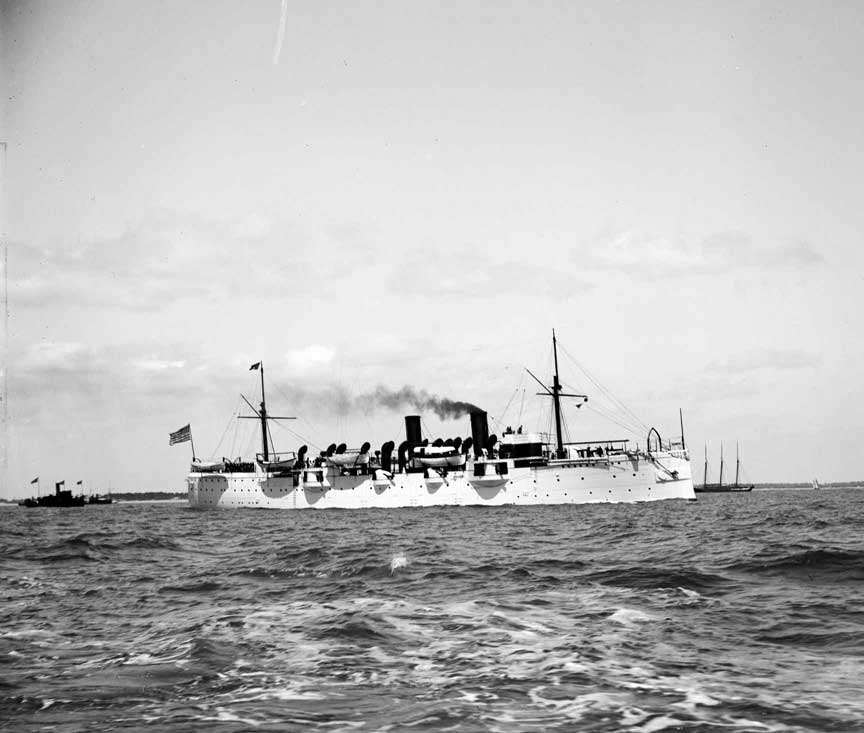USS Philadelphia C-4

Philadelphia IV
(C 4: dp. 4,324: 1. 335'; b. 48'6", dr. 19'2"; s. 19 k., cpl. 384;
a. 12 6", 4 6-pdrs., 4 3-pdrs., 2 1-pdrs., 3 37mm.)
The fourth Philadelphia, cruiser number 4, was laid down 22 March 1888 by Wm. Cramp and Sons, Philadelphia, Pa.; launched 7 September 1889; sponsored by Miss Minnie Wanamaker, daughter of merchant and philanthropist John Wanamaker; and commissioned 28 July 1890, Capt. B. F. Bradford in command.
While fitting out at the New York Navy Yard, Philadelphia was designated on 18 August as flagship of Rear Admiral Baneroft Gherardi, commanding the North Atlantic Squadron. The squadron departed New York 19 January 1891 to cruise the West Indies for the protection of American interests until May, thence to northern waters as far as Halifax, N.S. Early the following year the flagship called at Montevideo, Uruguay W18 February, after which she resumed cruising in the West Indies.
Philadelphia continued operations with the Atlantic Squadron along the eastern seaboard of the United States and in the West Indies until 1 March 1893. She was then assigned to the Naval Review Fleet as flagship of Rear Admiral Baneroft Gherardi. Charged with conducting the International Rendezvous and Review, with a fleet of twelve American ships, he received the visiting foreign ships as they commenced arrival in Hampton Roads 8 April. The fleet steamed to New York 24 April, where it joined additional foreign visitors to form a combined fleet of 35 men-of-war. President Cleveland reviewed the Fleet 27 April, after which appropriately festive ceremonies took place, initiating a parade through the streets of New York. The Naval Review Fleet disbanded 31 May. and Philadelphia departed New York 30 June 1893 bound for the Pacific Station via Rio de Janeiro, Brazil, and Callao, Peru.
Cruiser Philadelphia arrived San Francisco 22 August 1893. As the flaghip of the Commander-in-ehief,Pacific Station, she cruised with the squadron, engaging in drills and maneuvers, and visiting various ports on the west coast of the United States, Mexico, and South America, and in the Hawaiian Islands. She arrived at the Mare Island Navy Yard 14 October 1897 and decommissioned there 18 December.
Philadelphia recommissioned 9 July 1898 and became the flagship of Rear Admiral J. N. Miller, Commander-in-Chief of the Pacific Station. She steamed from San Francisco 2 July to participate in the ceremonies attending the assumption of sovereignty by the United States over the Hawaiian Islands. Flagship Philadelphia arrived Honolulu 3 August, and nine days hence her officers and those of the steam sloop-of-war Mohican, with a force under arms from the two warships. represented the United States Navy at the ceremonies transferring the Hawaiian Islands to the United States.
In March 1899, with Commander-in-Chief Rear Admiral Albert Kautz embark'ed, Philadelphia steamed to the Samoan Islands for duty in connection with the settlement of civil difficulties by the Samoan Commissioners of the United States Great Britain, and Germany. A landing party from Philadelphia went ashore in the vicinity of Vaiele 1 April to act in concert with a British landing party. The combined force, ambushed by adherents of Chief Mataffa, sustained seven killed and seven wounded, including two American officers and two bluejackets killed, and five bluejackets wounded. Philadelphia remained in the Samoan Islands until 21 May 1899, when she steamed for the west coast via Honolulu.
Philadelphia served as flagship of the Pacific Station until 6 February 1900, when Rear Admiral Kautz transferred his flag to Iowa (BB-4). The cruiser continued Pacific operations until 1902, conducting training cruises, drills, target practice, and port visits.
Returning from a six-month cruise off the Panamanian coast Philadelphia arrived San Francisco 17 July 1902. Needing extensive repairs, she was ordered to the Puget Sound Navy Yard for decommissioning. Arriving Bremerton, Wash. 23 August, she decommissioned at Puget Sound 22 September 1902.
Philadelphia was housed over and became a receiving ship at Puget Sound Navy Yard 12 May 1904. She continued this service until 4 November 1912, when she became a prison ship. Resuming service as a receiving ship 10 January 1916, she so remained until struck from the Navy List 24 November 1926. Cruiser Philadelphia was sold at public auction at the Puget Sound Navy Yard in 1927 to Louis Rotherberg.
 >
>